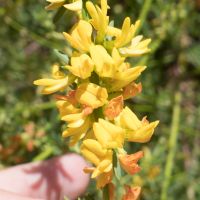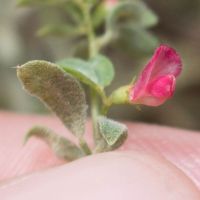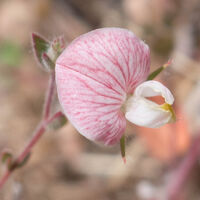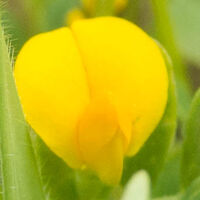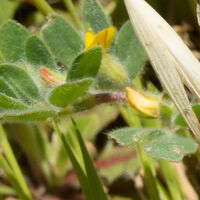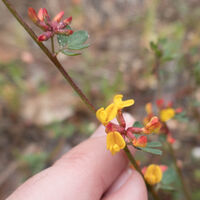deervetch
genus Acmispon
Member of
small yellow peas
legume family (family Fabaceae)
dicots (class Magnoliopsida)
flowering plants (subphylum Angiospermae)
Except for extremely rare examples that I don't expect to encounter, there are no other wild species of this genus in the bay area.
Caution: The key to distinguish these species is not complete.
Key features:
- stem erect, ascending, decumbent, or prostrate; woody (but green) or not
- number of leaflets per leaf, leaflets hairy or not
- number of flowers per leaf axil
- peduncle ≪ 1 cm or > 1 cm
- calyx lobe length relative to tube
- corolla color
- wings >, <, or ± = keel
See also Monterey County Wildflowers.
Jepson describes for many deervetch species whether the wings are ± greater or less than the keel. I assume that this measures their relative length, but the supposed differences are indistinguishable in CalPhotos.
1 flower per leaf axil
Acmispon americanus
- prostrate to erect, 5–60 cm
- generally 3 leaflets, often with simple upper leaves, 10–20 mm, lanceolate to elliptic
- leaflets lanceolate to obovate, ± equal
- 1 flower per leaf axil
- peduncle generally 15 mm (sometimes shorter), usually bracted (a single leaflet at the top of the peduncle and behind the flower) (example)
- calyx lobes ≫ tube (example)
- corolla 5–9 mm, ± white or yellow to pink, wings ± = keel
- common
These two are similar except for their calyx lobes.
Acmispon wrangelianus
- generally prostrate, branched at base, 5–30 cm
- generally 4 leaflets, palmate or nearly so, 4–15 mm, elliptic to obovate
- 1 flower 1 per leaf axil
- ± no peduncle and no bracts, so flower is sessile above a normal set of leaflets
- calyx strigose [often looks glabrous]
- calyx lobes ± 0.8–1.2 × tube
- corolla 5–9 mm, yellow, reddening in age, wings ± ≤ keel
- very common
- see also bur clover (Medicago polymorpha), which has 3 leaflets instead of generally 4
Acmispon brachycarpus
- mat-forming to ascending, 5–40 cm
- generally 4 leaflets, palmate or nearly so, 4–12 mm, elliptic to obovate
- 1 flower 1 per leaf axil
- ± no peduncle and no bracts, so flower is sessile above a normal set of leaflets
- calyx hairy
- calyx lobes 1–2 × tube
- corolla 5–9 mm, yellow, reddening in age, wings ± = keel
- scattered
1–2 flowers per leaf axil
strigose lotus
Acmispon strigosus
- prostrate, often mat-forming, generally branched from base, 3–50 cm
- leaf axis flat, ± blade-like
- 3–9 leaflets, lanceolate to obovate, ± equal
- inflorescence generally 1–2-flowered
- corolla 5–10 mm, yellow with ± salmon veins or wash (most visible on the back of the banner), or ± red in age, wings generally > keel
- 1–2 flowers per leaf axil, peduncle 3–25 mm, generally bracted (example)
- scattered
2+ flowers per leaf axil
coastal bird’s-foot trefoil
Acmispon maritimus var. maritimus
- prostrate or ascending, 5–50 cm
- 3–7 leaflets, irregularly pinnate, obovate to ± round, terminal generally largest
- peduncle generally > 1 cm, generally bracted
- generally 2–4 flowers per leaf axil (1st-formed may be only 1–2 flowers)
- corolla 6–10 mm, bright yellow, wings ± = keel; wings cup the keel often without touching each other
- Mt. Madonna
silver bird’s-foot trefoil
Acmispon argophyllus
- prostrate to erect, 10–60 cm
- leaflets with silvery hairs generally obscuring surface
- calyx 4–8 mm, lobes ± ≤ tube, densely shaggy-hairy
- 4–15 flowers per leaf axil
- corolla 6–12 mm, wings ± = keel
- extremely rare at La Honda Creek
chaparral lotus
Acmispon grandiflorus var. grandiflorus
- decumbent to erect, 10–40(150) cm
- 7–9 leaflets, generally 10–15 mm; leaf axis (including petiole) 10–35 mm
- leaf axis not flat or blade-like
- inflorescence 3–9-flowered
- corolla 15–25 mm, cream/yellow to red-purple [Jepson is wrong], wings ± ≥ keel
- Mt. Tam
bentham’s broom
Acmispon cytisoides
- perennial herb; mat-forming or low-ascending, not woody, 10–80 cm
- 3–5 leaflets, 5–12 mm, glabrous or finely strigose
- calyx lobes narrow, some or all curved outward or hooked
- corolla 8–10 mm, generally white to ± pink (to brick-red when dry, wings cream), often dark-striate, in clusters of 3–10
- Butano, Mt. Montara vicinity
Acmispon heermannii var. orbicularis
- perennial herb; prostrate, often mat-forming, 30–100 cm
- 4–6 leaflets, 4–16 mm, densely white-hairy
- corolla generally 4–6 mm, yellow to ± red, dark-tipped, wings ≥ other petals [wings < banner in other species?], in clusters of 3–8 with 1–5 mm pedicels
- scattered in the Santa Cruz range
san diego bird’s-foot trefoil
Acmispon micranthus
- rare in the south bay
canyon birdsfoot trefoil
Acmispon argyraeus
8 observed taxons / 7 unobserved taxons / 2 keys
Locations: Months: For more details, use advanced search.
Chris’s observations: 120 (76 are research grade)
Taxon info: iNaturalist – Calflora – Jepson eFlora – FNA
Bay Area species: iNaturalist – Calflora
